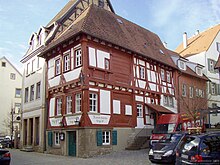Ratsschänke (Eppingen)
The building called Ratsschänke in Eppingen in the Heilbronn district in northern Baden-Württemberg is a historic half-timbered house on the town's old market square.
history
The building on the corner of Altstadtstrasse / Zunfthausgasse (house Altstadtstrasse 5) stood for a long time next to the old town hall , which was demolished in the 19th century, on the medieval old market square, the city's historic economic center. Older literature dates the house to the year 1388, as the date in Arabic numerals was on a corner beam . Both half-timbered construction and dating with Arabic numbers would be extremely rare for that time. Based on the construction year 1388, the house would probably have been built by the Eppinger family Hug (or Haug), whose heraldic animal is the one-headed eagle on a beam head, which is sometimes interpreted as an early city coat of arms. The wealthy Haugin , Katharina Hugin, donated the Nikolauspfründe in 1421 . According to the dating of 1388, which has since been discarded, the building was considered the oldest half-timbered house in Elsenzgau . Since it has been assumed that the Ratsschänke was not built until the late 15th century, the bakery from 1412, a little further to the east, has been the oldest known half-timbered house in the Kraichgau.
More recent findings and a date that can be found today on a beam head name the year of construction of the Ratsschänke with 1483. The building was the chaplainhouse of the Nikolauspfründe before it came to the spiritual administration of the Electoral Palatinate in Heidelberg in the course of the Reformation , which it on April 23, 1584 sold for 300 guilders to the mayor and council of the city of Eppingen. In the possession of the city, the house was probably used as an official residence for city clerks or mayors and was maintained by the city.
On February 11, 1749, the town hall, along with the town hall, went to Johann Georg Rieger for 390 guilders, who on the same day also acquired the town meat house (today's Old University ) for a further 400 gulden . The house has changed hands frequently to this day, the exact ownership history is only partially known.
The two-storey half-timbered building once had three storeys. However, the upper storey and the gable roof were removed after the First World War due to a threatening tilt, and instead the remaining building was covered with a hipped roof. The half-timbered structure of the building was temporarily covered by plaster .
The building is mostly called a town house in old documents and could also be identical to the upper town hall mentioned in the early 18th century . The name Ratsschänke has only recently developed and refers to the old town hall that was once adjacent. However, a restaurant has only been in the building for a few years; historically, such use of the building has not been proven.
literature
- Franz Gehrig : The "Ratsschänke". The oldest half-timbered house in Elsenzgau . In: Around the Ottilienberg . Volume 2. Heimatfreunde Eppingen , Eppingen 1982, pp. 48-50
- Stefanie Pfäffle: English red means cherry red here . In: Heilbronn voice . July 3, 2007 ( from Stimme.de [accessed on May 31, 2009]).
Web links
Coordinates: 49 ° 8 ′ 14.2 " N , 8 ° 54 ′ 38.5" E

